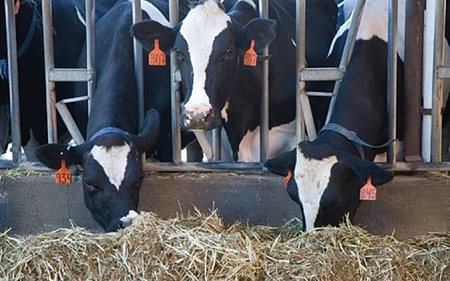CEDERS
Searching for climate-friendly cow feed

Scientists from nine countries, including the Netherlands and New Zealand, are working together on a common database for climate-friendly cow feed. ‘I have already learnt a lot more about different dairy farming systems and feed management options’ says Cecile de Klein, a researcher at AgResearch in New Zealand.
Every region in the world has its own best practices for feeding cows. For example, most dairy cows in New Zealand eat fresh grass, while their Spanish counterparts, most of which live in barns, are fed chopped maize and concentrates, and many Indian cows have to make do with sugar cane or elephant grass. The question is: could farmers start feeding cows in such a way that they keep performing well, or even better, while substantially reducing emissions of methane (CH4) and nitrous oxide (N2O)?
150 feed characteristics
Experiments have already demonstrated that some crops, varieties or mixtures deliver better results than others. To help farmers select the most climate-smart feed, the participating researchers in the international project CEDERS are now expanding their common database, comprising 150 feed and animal characteristics. CEDERS is one of the projects funded through the ERA-NET Cofund FACCE ERA-GAS first joint call for proposals. The database (a so-called ‘treatment mean database’) expands on the database available from the Global Network project led by Alex Hristov (Penn State University) funded through the Multi partners call of FACCE-JPI. Database parameters include feed intake, feed composition (sugars, starch, fibre, protein, fat), feed digestibility and nutrient excretion, and emissions of methane. ‘Together, we collect and align the data to provide insight into the different effects that feeding habits have on greenhouse gas emissions’, says Cecile de Klein, a member of the project team.
General rules
A well-defined database helps with the development of computer models that assess greenhouse gas mitigation as a result of specific farming systems (including manure management) and feeding strategies. Other regions can compare results of their own experiments to the findings in this database. ‘We expect to find general calculation rules’ says de Klein. For example: crops or forage with high levels of fibre, will lead to more greenhouse gas emission than crops with more sugar or fat. A better understanding of such relationships can be used to improve the national inventories of greenhouse gas emissions.
Climate respiration chambers
Data originate from all kinds of feeding experiments and measurements of gas emissions via the animals or from manure. Some research groups are conducting precise and advanced measurements, using climate-controlled respiration chambers. Others adopt less expensive and less laborious measurement techniques, for example in barns or in open fields. ‘That does not hinder the collaboration’, says project coordinator André Bannink from Wageningen Livestock Research. ‘Depending on the aim of the research, sometimes the cheaper method is to be preferred, and sometimes the more advanced method. For example, when we want to demonstrate minor effects such as those caused by differences in grass characteristics, we need respiration chambers.’
Collaboration with farmers is in the pipeline. The researchers want to use their calculation rules to generate topical figures from different, well-described farming systems across the nine participating countries. In this way, they hope to improve and align existing greenhouse gas accounting methods such as Annual Nutrient Cycling Assessment (KringloopWijzer), a management tool that Dutch farmers already use to provide management and performance figures for the dairy industry. The figures also include manure production. The project team will continue to manage the database after 2020. Other groups can make use of the database as well, as long as they involve the team, says Bannink. ‘We would like to see conclusions drawn from our database with methods that we can support.’
Pasture management
The collaboration with New Zealand has added value, above collaboration with only EU-partners, says André Bannink. New Zealand has a lot of expertise in both pasture management, measuring greenhouse gas emissions and fundamental science that is useful for all partners. Cecile de Klein also welcomes overseas collaboration. ‘I have already learnt a lot more about different dairy farming systems and feed management options’. Moreover, New Zealand strongly promotes exchange with scientists from other region and continents.
Worldwide database
Both André Bannink and Cecile de Klein support the global expansion of the database, which could be managed by one of the network groups active under the Global Research Alliance on Agricultural Greenhouse Gases (GRA). The GRA is an alliance of over 50 countries in which the Netherlands and New Zealand are leading partners. The work of CEDERS is already carried out in close collaboration with the Feed and Nutrition Network group of the GRA.
Partners in this project (2017-2020): The Netherlands, France, United Kingdom, Denmark, Sweden, Finland, Germany, Ireland and New Zealand.
Researchers in the spotlight with projects funded through jointly programmed calls
One of the aims of joint programming is aligning research & research funding and this usually results in a joint call to which proposals can be submitted. In a series of interviews, researchers from Wageningen University and Research present their granted projects from such joint calls.
